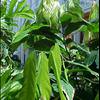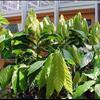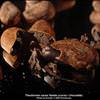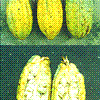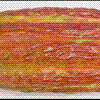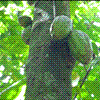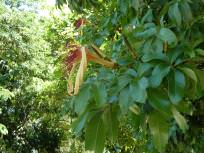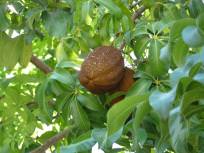This plant may be available to buy
Click the banana to see

|
Chocolate Tree click pics to enlarge |
|
Zone 10, 11, 12 The Chocolate Tree was named Theobroma cacao and that Latin means 'food of the gods.' If the gods eat chocolate and cacao, so does everybody else. The USA alone consumes 3 billion (not million) pounds per year. Worldwide production is more than a million tons Fruit / Seeds, click to enlarge Native to the rain forests of the tropical Americas, Theobroma cacao is now grown worldwide in equatorial climates like South America (Brazil and Ecuador), Mexico, Costa Rica, Java, Ceylon, Ghana, Nigeria, etc. primarily between latitudes 10 deg N to 10 deg S, and preferably at an altitude of 1,300 to 2,300 feet Mayan Indians first cultivated the Chocolate Tree, a tropical evergreen with large glossy drooping leaves, about 1,500 years ago, concocting foamy chocolate drinks from the fruit, which are the seeds of the cacao tree When seeds are ripe, they can rattle when shaken in the pod they grow in or taken more fresh before they rattle; and each 5-12 inch pod contains about 25-40 seeds.Pods can be green, yellow/golden, red to purple in color. The Chocolate Tree bears flowers and fruit all the year, but the typical seasons for harvest are June and December. A mature tree's pods require 10-12 pods per pound of cacao produced Selected pods are roasted, then the kernels are pressed through rollers and the result is a dark brown paste called chocolate liquor. Chocolate liquor is the base product from which all chocolate is made. Sugar, butter, etc are added Sources differ as to tree size. Some say as small as 12-16 feet while others say 20-25 feet and one says 25-39 feet. Regardless, the Chocolate Tree prefers rich soil, high humidity and shade (like the coffee tree) from the harsh sun hours. Banana trees often are planted to provide the shade or other tall rain forest trees Fascinating is the pollination of the Chocolate Tree. New evidence discovered by Allen Young, a leading cacao expert, indicates that a tiny fly, the size of pin head, is the primary (if not only) pollinator of the complex cacao flowers. The fly is called a midge and without its work, there would be no chocolate. However, only 1-3% of flowers (many hundreds) are fertilized and bear fruit Note also there are traditional organic cultivation methods to grow Theobroma cacao as well as "modern" chemical farming. You can buy either product, but organic is better for you and the planet Also, here's a photo of a hydroponic cacao plant at EPCOT in Orlando
But wait ... There's More !!! New research released October 2003 indicates that cocoa is way the most powerful antioxidant on the planet. With a new level of pleasure you can now fight heart disease, cancer and enjoy chocolate at the same time you sip your red wine The top 4 antioxidants are:
Published in the Journal of Agricultural and Food Chemistry released October 2003, this Cornell University co-sponsored study shows that cocoa is 2 times better antioxidant than red wine and cocoa is 5 times better than black tea If all that is not enough excitement for you, the chocolate tree's close relative is Theobroma grandiflorum, often called by the common name Cupuacu or Cupuassu. It may be this plant (below) the Aztecs drank rather than cacao click pics to enlarge |
